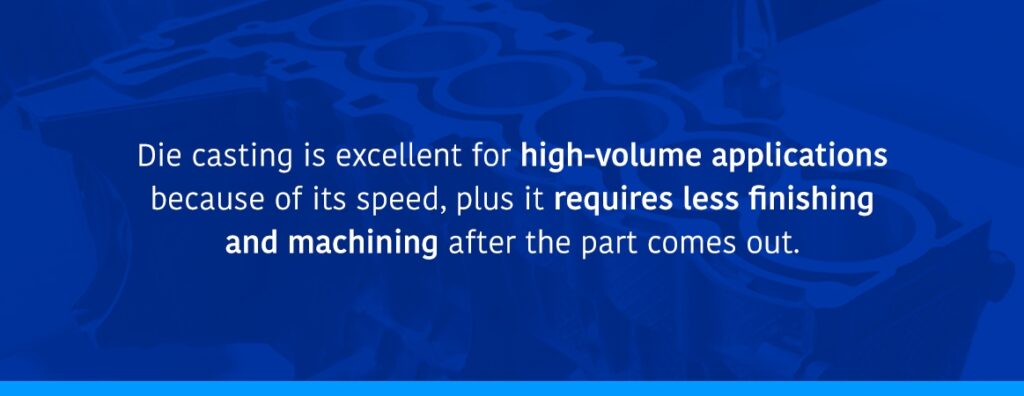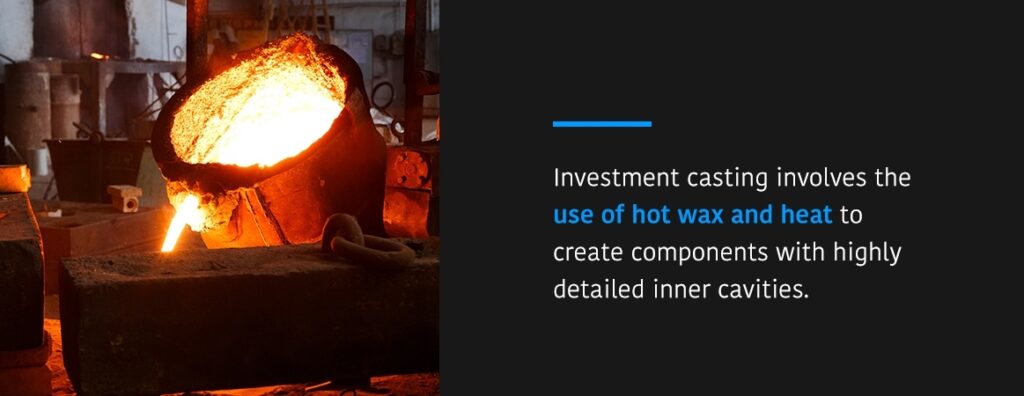
Tolerance standards in die casting are determined by the type of metal alloy used and specific elements of the object being cast, such as size and length. It’s essential to consider the part as a whole when you’re manufacturing pieces. However, additional components like the proximity of features within the part and those features’ proximity to other components are equally important.
Depending on the level of tolerance, a part may fall out of tolerance and still work effectively. Tighter tolerances result in more precise products, but they come with their own set of concerns that can pose a challenge when creating extremely particular components. It’s always best to tolerance an object by following the die casting industry standards and adjusting from there.
Tolerances are used in more than die casting — these measurements come up in other production processes like sand casting, investment casting and machining. The process you choose will depend on numerous factors, including the tolerance standards for each. Which one is best for your next manufacturing project, and how do the tolerances measure up to each other? This guide can help you decide which process will prove the most efficient for your facilities.
Standard tolerances encompass a range of applications concerning function, fit and form — they’re less precise than precision tolerances. Both are expressed in units such as thousandths of an inch and hundredths of a millimeter. However, precision tolerances have a lower range of acceptable degree variation in design-specified values. Precision tolerances allow for a higher level of accuracy when producing parts, but they may also create setbacks, like frequent die inspections and repairs and reduced die life cycles.
Precision tolerances may also cost more to use because the die must be more rigid and undergo more testing than a standard type. Standard tolerances give you a greater range for out-of-tolerance parts and ensure a more predictable service — whereas precision often calls for particular specifications. Both types cover a few common dimensional categories, which are:
Die casting industry standards are defined by both the North American Die Casting Association (NADCA) and the international ISO series. Dimensional tolerances encompass both the dimensions for one die half and dimensions over the parting line. These guidelines cover metals like aluminum, copper, zinc and magnesium and are categorized by being either standard or precision. At Premier Die Casting, we specialize in aluminum and zinc die casting, which are the two materials we’ll cover here.
Aluminum die casting enables a higher manufacturing rate than many other metal alloys. This technique also tends to be less costly. It yields lightweight but durable parts ready for any application. NADCA dimensional tolerances for one aluminum die half are as follows:
Additionally, NADCA provides a set of cast component tolerance standards regarding dimensions over the parting line. These measurements are determined by the projected area of the die casting and expressed in inches squared. The standard tolerances for aluminum are:
The precision tolerances for the projected area of the die casting are defined by these units:
Many manufacturing experts consider zinc the easiest metal to cast with. It offers a range of benefits because of this versatility. Some advantages include maximum strength and hardness, corrosion resistance and higher dimensional stability than other metals. According to NADCA, its tolerances for one die half are:
The U.S. tolerance standards for zinc die casting include standard tolerances for an object’s parting line, which are:
The following are the zinc die casting precision parting line tolerances:

Die casting is excellent for high-volume applications because of its speed, plus it requires less finishing and machining after the part comes out. It yields tighter tolerances because of the intricate nature of the molds commonly used.
When you need a part with extreme precision, it’s often best to choose computer numerical control (CNC) machining. Producing thousands of detailed parts that need to be identical can be difficult without the help of a CNC machine. Industries like telecommunications and electrical housing use high-precision, complex parts that can usually only be produced with machining. You can also use this technique to add features to an already existing piece, such as one formed from die casting.
It’s essential to keep in mind that material also matters when manufacturing a part with CNC machining. If you’re following very tight tolerances but the material is of a softer variety — like plastic — it may flex while it’s being cut. This factor can make it difficult to machine a plastic part without making room for specific tooling considerations.
Machining with billet materials can be cost-effective if you’re only producing a low quantity of detailed components, but expenses increase as the amount of work does. This method also requires more time than die casting — both the process itself and the act of setting up the milling or turning center. And though it yields high-precision designs, not all designs can be created from solid billet, nor is it cost-effective to do so.
ISO 2768 covers tolerances for pieces made by machining sheet metal or removing metal. The tolerance cast designation is split into four categories — fine, medium, coarse and very coarse. Using the “fine” designation as an example, here are the permissible deviations for machining when following the standards for linear dimensions:
Like die casting, sand casting can accommodate complex designs and is compatible with a range of metal alloys. The size of the parts you create with this process can be a few ounces or a few tons — sand casting offers plenty of versatility regarding parts manufacturing. Because of the mold’s ability to withstand high temperatures, it works well with metals such as titanium and nickel.
This method does have multiple disadvantages when compared to die casting. Sand casting requires you to make a new die every time you create a part, which can become time-intensive and expensive. Although you can recycle and reuse the sand, it’s much more efficient to use a steel die that’s already formed and ready to go for the next set of parts. Using sand also means you’ll need to spend time cleaning the cast object. In general, casting with sand tends to be more labor-intensive.
High-precision work is possible with this method, but it doesn’t possess the same level of accuracy as a die because it uses a loose material rather than metal. You’ll also get much higher tolerances when dealing with die casting, which is why it’s less expensive than sand. Though precise tolerances can lead to more expenses, so can loose ones. If your parts come out low-quality, you’ll spend more time and money making new ones with higher tolerances.
To see how die casting and sand casting truly measure up, you’ll need to be familiar with sand casting tolerances. Different tolerances exist depending on whether you’re completing a long-production series or short-production series. Within those tolerances, the specific conditions you’re working with determine a range of acceptable tolerance grades.
As an example, here are the industry-accepted sand casting tolerance standards for a long-production series within the CT 10 tolerance grade:

Investment casting involves the use of hot wax and heat to create components with highly detailed inner cavities. People also refer to this method as lost wax casting. Engineers employ this method by creating molds from wax patterns and coating them in a slurry consisting of ceramic refractory material. Once this dries, they remove the wax by applying heat, leaving the ceramic or plastic mold behind.
Because investment casting consists of multiple detailed steps, it takes more time than many other processes. You can expect a similar level of expenses like what you’d see with sand casting because of the complexity and amount of labor. Also similar to sand casting, investment casting requires new materials after producing each part. This technique can be even more resource-intensive because it doesn’t involve recycling — the materials used for the mold aren’t reusable.
Variations outside of the approved investment casting tolerance standards usually result from shrinkage, tooling and process variation. Tolerances for investment casting range from +/- 0.005 inch to 1 inch, with every inch after that being an additional +/- 0.005 inch. Investment casting offers a broader tolerance range than die casting — which is +/- 0.002 inch to 1 inch — which means the die casting method may be the better choice for you if you’re looking for higher accuracy.
Vacuum casting — alternately known as V-casting — also involves sand, but the process is different from the usual sand casting technique. Manufacturers use a vacuum to form the sand into the shape of the component they’re going to cast. By placing a plastic film over the pattern, they use a vacuum to seal the material and then encapsulate it with a flask. They then fill the flask with fine sand, place a second sheet on the flask and vacuum seal it. The result is a complete mold held together with a vacuum seal.
No sand mixers — or other types of equipment you’d use for hardened sand — are necessary for this method, as it doesn’t use any pressurized compaction strategies. This factor can reduce some of the costs associated with regular sand casting.
V-casting enables you to manufacture parts by reusing the same patterns. There’s also less scrap material left afterward, which makes the technique more efficient and waste-conscious. Its size range goes up to 150 lbs, and its tolerances range from +/- 0.010 inch to 1 inch, with every inch afterward being an additional +/- 0.002 inch. Similar to investment casting, it offers a wider tolerance range than die casting, which may be unfavorable or preferable depending on your manufacturing needs.
If you’re seeking die casting services to produce the highest-quality parts, Premier Die Casting can help. We’ve been in the industry for over 70 years and offer die casting, machining, metal finishing services and more. As a family-owned, U.S. based company, we ensure you receive fast, reliable service and durable die-cast parts from the most experienced professionals.
Our Quality Policy and ISO 9001 certification keep us accountable for the work we do. We strive to bring you only the best parts and services each time. Whether you’re in the medical, automotive or lighting industry, you can find a solution to your die casting needs at Premier Die Casting. Contact us today with the die casting project you have in mind, and we’ll work with you to create a top-class, long-lasting end product.








